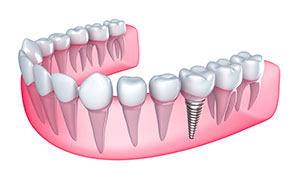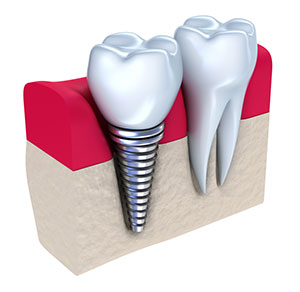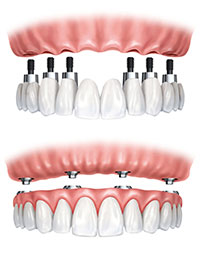
Dental Implants In La Mesa, CA
What Is a Dental Implant?
It Looks and Feels Like a Natural Tooth
A dental implant is an artificial tooth root that replaces a missing tooth. It is made of a titanium alloy, a bio-friendly material. Dental implants are used to replace one or several missing teeth. They are surgically placed into the jawbone to create the basis on which the prosthetic teeth will be built. In time, bone develops around the implant, reinforcing it into the jaw and fusing it with the surrounding bone. Dentists use implants to make crowns that have the same appearance and texture as natural teeth.
Dental implants – the perfect solution!
As opposed to bridgework, a partial or complete denture, which used to be the solution of choice for the treatment of missing teeth, dental implants do not move and do not damage adjacent, healthy teeth.
Dental Implant – The Solution
The implant is placed in the jawbone and does not rely on adjacent teeth for support. It allows a person to exert more chewing pressure than with dentures, facilitates clarity of speech, which is highly impaired by dentures. 
Risk OR Opportunity
Implants are placed in the jawbone during a minor surgical procedure at the dentist’s office, under a local anesthetic. Long-term studies show that success rates reach 95%. However, implant failure or partial absorption may stem from various reasons such as patient’s health conditions that may contraindicate implantation, lack of cooperation from the patient, drug abuse, poor oral hygiene, emotional problems, chronic alcoholism, smoking, and problems related to the quality and density of the bone.
Dental implants are a success but not at any cost and not for everybody. Consult your dentist before embarking on the procedure.
Single-Tooth Rehabilitation/ Replacement
When replacing a single tooth, a dental implant is the ideal solution. This is because the implant does not need the support of other teeth and therefore does not harm adjacent, healthy teeth.  It is not recommended to leave the jaw with a missing tooth. This condition may cause the bone to deteriorate, and may require bone augmentation.
It is not recommended to leave the jaw with a missing tooth. This condition may cause the bone to deteriorate, and may require bone augmentation.
Multiple-Teeth Rehabilitation/ Replacement
Implants can be used to support multi-unit bridges, allowing a rehabilitation of partially edentulous patients with a fixed prosthesis.
Rehabilitation/ Replacement of All Teeth
When all teeth are missing in both the upper and lower jaws, the best solution is dentures supported by implants. The denture is anchored using special attachments that snap into place onto the implants for optimum retention. A full denture that is not retained by dental implants affects speech, eating habits, facial features, and in general, the person’s lifestyle.

How Does the Implant Work?
Process Highlights
Diagnosis – During the preliminary examination, the dentist checks the location of the blood vessels, nerves and air pockets in the jaw. Based on the results of a panoramic X-ray or CT, the dentist decides on the most suitable implant, its length, width and location in the jaw.
Implant placement – The implant is inserted in the jawbone at the dentist’s office in a surgical setting. The procedure takes less than one hour.
Healing – After 3 to 6 months, when the area has healed and the implant has fused with the jawbone, the implant is exposed.
Rehabilitation – In this stage, a crown is built over the implant. It takes several weeks until the desired results are obtained.
